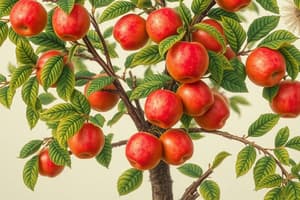Podcast
Questions and Answers
Quả táo thuộc loại trái cây nào?
Quả táo thuộc loại trái cây nào?
- Trái cây nhiệt đới
- Trái cây cận nhiệt đới (correct)
- Trái cây họ cam quýt
- Trái cây hạch
Táo có nguồn gốc từ đâu?
Táo có nguồn gốc từ đâu?
- Châu Á (correct)
- Châu Mỹ
- Châu Phi
- Châu Âu
Tại sao táo lại được coi là trái cây bổ dưỡng?
Tại sao táo lại được coi là trái cây bổ dưỡng?
- Ít calo và không chứa chất béo
- Chứa nhiều đường và calo
- Có tác dụng làm hạ huyết áp
- Giàu vitamin C và chất xơ (correct)
Quả táo có thể được ăn theo dạng nào?
Quả táo có thể được ăn theo dạng nào?
Màu sắc nào không thường gặp ở quả táo?
Màu sắc nào không thường gặp ở quả táo?
Flashcards
Apple
Apple
Từ "táo" trong tiếng Anh.
Táo
Táo
Từ "táo" trong tiếng Việt.
Study Notes
Botanical Information
- Apple (Malus domestica) is a deciduous tree fruit.
- Originating in Central Asia, it has been cultivated for thousands of years.
- Various cultivars (cultivated varieties) of apples exist with diverse characteristics in size, shape, color, and taste.
- Apples are a pome fruit, meaning they develop from an enlarged flower receptacle surrounding the seeds.
Nutritional Value
- Apples are a good source of dietary fiber.
- They contain various vitamins and minerals, including vitamin C, potassium, and antioxidants.
- Apples' nutritional profile varies depending on the cultivar.
- They are relatively low in calories.
Growing Conditions
- Apple trees thrive in cool temperate climates with sufficient rainfall or irrigation.
- They need well-drained soil.
- Specific soil pH and nutrient levels may be required for optimal growth and fruit production.
- Careful pruning and other agricultural practices are essential for orchard management.
Harvesting and Storage
- Apples are typically harvested in the fall.
- Proper harvesting techniques minimize damage to the fruit.
- Storage conditions, such as temperature and humidity, play a critical role in maintaining freshness and extending the shelf-life of apples.
- Different cultivars have varying storage capabilities.
Uses and Applications
- Apples are enjoyed fresh as a snack.
- They are used for making juices, jams, and pies.
- Cider production utilizes apples.
- Apples are incorporated in various baked goods and desserts.
- Apple byproducts, like apple pulp, are also sometimes used in other processed products and nutrition/health supplements.
Health Benefits
- Apples are associated with potential health benefits due to their fiber, antioxidants, and other nutrients.
- Consumption of apples might correlate with a lower risk of certain diseases.
- However, more research is often needed to confirm specific correlations between apple consumption and health outcomes.
Types of Apples
- Numerous varieties of apples exist, each with distinct flavors, colors, and textures.
- A few examples of well-known varieties include Granny Smith, Red Delicious, Fuji, Honeycrisp, and Gala, each offering distinct sensory profiles.
- Considerable genetic diversity exists between cultivars, leading to significant variation.
Cultural Significance
- Apples feature in many cultures.
- Symbolic meanings and cultural uses may vary across different regions.
- Apples often symbolize abundance, health, and prosperity in various contexts.
Studying That Suits You
Use AI to generate personalized quizzes and flashcards to suit your learning preferences.




